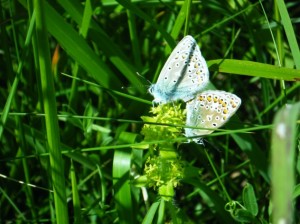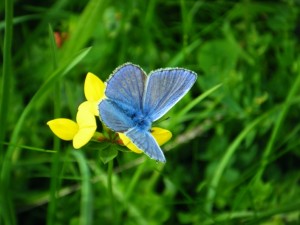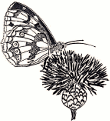 Fourteen of us gathered at the Visitor Centre for the field trip at Crickley Hill. Bob Wills who currently does the transect there and David Perkins who used to do the transect came along to show us the best places to see the butterflies. Early June is not usually thought of as a good time for butterflies. Often it is call the June droop or June gloom as it is in between the spring butterflies and the summer butterflies. However in the countryside, particularly on unimproved limestone grassland sites, there are usually quite a few butterflies flying.
Fourteen of us gathered at the Visitor Centre for the field trip at Crickley Hill. Bob Wills who currently does the transect there and David Perkins who used to do the transect came along to show us the best places to see the butterflies. Early June is not usually thought of as a good time for butterflies. Often it is call the June droop or June gloom as it is in between the spring butterflies and the summer butterflies. However in the countryside, particularly on unimproved limestone grassland sites, there are usually quite a few butterflies flying.
 As it was rather windy, there were few butterflies flying around the car park and the top of the hill, so we made our way down the slope and started to see several butterflies. In total we did see quite a few including Small Heath, Common Blue, Brown Argus, Dingy Skipper, Large Skipper, Speckled Wood and a couple of very faded Green Hairstreak. We also saw quite a few different day-flying moths including 6-spot burnet moth, Burnet Companion, Common Heath, Thistle Ermine, Speckled Yellow and Cistus Forester moth. We also saw two Common Blues mating which was quite a treat.
As it was rather windy, there were few butterflies flying around the car park and the top of the hill, so we made our way down the slope and started to see several butterflies. In total we did see quite a few including Small Heath, Common Blue, Brown Argus, Dingy Skipper, Large Skipper, Speckled Wood and a couple of very faded Green Hairstreak. We also saw quite a few different day-flying moths including 6-spot burnet moth, Burnet Companion, Common Heath, Thistle Ermine, Speckled Yellow and Cistus Forester moth. We also saw two Common Blues mating which was quite a treat.
 Most of these butterflies are quite small and some look alike and so are tricky to identify. One of the most difficult is differentiating between a male Brown Argus and a female Common Blue. Both are brown with orange spots at the edge of their wings which fade away towards the tip of their forewings. There is usually some blue dusting on the bodies and wings close to the bodies on female Common Blue which is not there on Brown Argus. A more definitive way to tell them apart is to look at the underwing. There is a spot close to the body on a Common Blue which is missing on a Brown Argus. Of course to see this, the butterfly needs to have its wings closed and the observer needs to be able to get close enough to see or else have good binoculars or good eyesight! Even with these methods of telling them apart it can still be quite tricky. We did have quite a bit of practice however as we did see quite a few Common Blue and Brown Argus.
Most of these butterflies are quite small and some look alike and so are tricky to identify. One of the most difficult is differentiating between a male Brown Argus and a female Common Blue. Both are brown with orange spots at the edge of their wings which fade away towards the tip of their forewings. There is usually some blue dusting on the bodies and wings close to the bodies on female Common Blue which is not there on Brown Argus. A more definitive way to tell them apart is to look at the underwing. There is a spot close to the body on a Common Blue which is missing on a Brown Argus. Of course to see this, the butterfly needs to have its wings closed and the observer needs to be able to get close enough to see or else have good binoculars or good eyesight! Even with these methods of telling them apart it can still be quite tricky. We did have quite a bit of practice however as we did see quite a few Common Blue and Brown Argus.
Thanks to Bob Smith and Bob Wills for catching some of the butterflies and moths in pots so that we could view them at close quarters.
The weather was quite good and we had quite a few sunny spells. However the afternoon did end rather suddenly as big black clouds made their way towards us and we all made hasty retreats back to the car park.
Thanks to Bob and David for guiding us to the best spots to see the different butterflies. Of course the ‘best spots’ on Crickley depend on the weather on the day and the time in the season.
Tricia Atkinson 13th June 2014
(Thanks to Diane Higgens for the photos of the butterflies)

 Internal Pages
Internal Pages

